Modern equipment of the British Army
 |
| British Army of the British Armed Forces |
|---|
| Components |
| Administration |
| Overseas |
| Personnel |
| Equipment |
| History |
|
|
Modern equipment of the British Army is a list of the equipment currently in use with the British Army. It includes small arms, combat vehicles, aircraft, watercraft, artillery and transport vehicles. The primary task of the British Army is to help defend the interests of the United Kingdom, but it can also serve as part of a North Atlantic Treaty Organisation (NATO) force, or a United Nations (UN) or any other multi-national force. To meet its commitments, the equipment of the army is constantly updated and modified. To meet any shortage or requirement on operations, the army can request equipment under an Urgent Operational Requirement (UOR), which supplements planned equipment programmes.[1]
Infantry section equipment

The infantry section normally has two four-man infantry fire teams. On operations, each fire team is usually equipped with the following:[2]
- Weapons
- 1 × L85A2 rifle
- 1 × L85A2 rifle with L123A2 UGL (underslung grenade launcher)
- 1 × L129A1 DMR rifle or 1 × L86A2 Light Support Weapon (LSW)
- 1 × L110A2 Minimi light machine gun
- 1 × AT4 84mm anti-tank weapon
- 1 × L72A9 light anti-structure munition
- 4 × L84 White phosphorus smoke grenades
- 8 × L109A1 High explosive grenades
- 4 × L132A1 Smoke grenades
- Vision systems
- 3 × Sight Unit Small Arms, Trilux (SUSAT) or SpecterOS[3] Lightweight Day Sights (LDS)
- 1 × Advanced Combat Optical Gunsight (ACOG) to be used with the L129A1 DMR rifle
- 2 × Image intensified Common Weapon Sights
- 3 × Laser Light Module Vario Ray Adaptive Target Acquisition Modules[4]
- 1 × TAM-14 small Thermal Imaging System
- 1 × Head mounted Night Vision System (HNVS)
- 2 × VIPER 2+ thermal imaging weapon sights
- 2 × Commander's target locating systems (CTLS)
- Communications equipment
- 4 × Personal Role Radio (PRR) - one issued to each member.[5]
- 1 × Bowman secure VHF Radio
Weapons
Pistols
| Name | Origin | Type | Cartridge | Photo | Notes |
|---|---|---|---|---|---|
| L9A1 | |
Semi-automatic pistol | 9mm Parabellum | Standard issue pistol. It is a self-loading, semi-automatic pistol chambered in 9mm NATO. It has been in service since 1954, but is currently being replaced by the Glock 17 Gen 4. | |
| L105A1 & L105A2 L106A1 L107A1 L117A1 |
|
Semi-automatic pistol | 9mm | 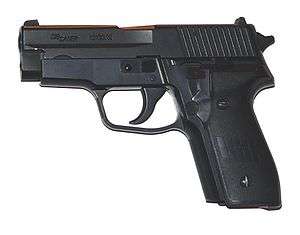 |
Variants of the SIG Sauer P226 were purchased as an interim replacement for the L9A1 as an Urgent Operational Requirement (UOR) for use in Afghanistan. Although purchased as an interim weapon, they will continue to be used until the end of their life cycles.[6] |
| L131A1 | |
Semi-automatic pistol | 9mm |  |
Glock 17 adopted as new standard issue pistol, replacing the L9A1 'Browning' and, eventually, the SIG Sauer. Around 25,000 have been purchased.[7] |
Assault, battle rifles
| Name | Origin | Type | Cartridge | Photo | Notes |
|---|---|---|---|---|---|
| L85A2 L22A2 |
|
Assault rifle Carbine |
5.56×45mm | .jpg) |
The L85A2 (IW) is the standard assault rifle.[8] It can be fitted with SUSAT, ACOG, Elcan Specter OS 4X or Thermal Viper 2 sights. A LLM-Vario Ray laser aiming module can be attached.[4] Other attachments include the L123A1 Underslung Grenade Launcher (UGL), which is complemented by the new 'Rapid Acquisition Aiming Module' for better accuracy and range.[9] The L22A2 is a shortened carbine used primarily by vehicle and helicopter crews for self-defence. |
| L86A2 | |
Light support weapon | 5.56×45mm |  |
The L86A2 (LSW) is the standard light support weapon. It features a longer barrel, a bipod and a shoulder strap for greater range and accuracy. Many parts are interchangeable with the SA80, including the same magazine. The LSW is capable of a high rate of accurate rapid fire at ranges up to 1,000 meters.[10] It is currently being upgraded with picatinny rails and a new muzzle, stock and bipod. |
| L119A1, L119A2[11] | |
Assault rifle | 5.56×45mm |  |
The weapon is used by the pathfinder group of the Parachute Regiment, UKSF, the Royal Military Police Close Protection Unit and 43 Commando Royal Marines.[12] Attachments include the L17A1.[13] It has been upgraded from the A1 to the A2 variant.[11] |
| L129A1 | |
Sharpshooter rifle | 7.62×51mm | 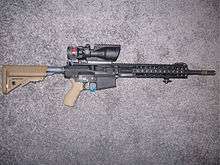 |
The primary designated marksman rifle. It is equipped with an ACOG optical sight for long-range engagements.[14] At least 1,500 rifles had been delivered by May 2013.[15] There is also a Sniper Support Weapon version of the L129A1, with 12x Schmidt & Bender sights and a suppressor, to be used by the second man in each sniper team. |
| HK417 | |
Sharpshooter rifle | 7.62×51mm | |
Battle rifle used by the Royal Military Police Close Protection Unit and UKSF[16] |
Shotguns
| Name | Origin | Type | Cartridge | Photo | Notes |
|---|---|---|---|---|---|
| L128A1 | |
Semi-automatic shotgun | 12-gauge | |
Has a capacity of eight rounds and a maximum effective range of 140 m (460 ft) for solid shot and 40 m (130 ft) for buckshot.[17] |
| L74A1 | |
Pump-action shotgun | 12-gauge | |
Used by UKSF as a breaching shotgun.[18] |
Sniper and Anti-materiel rifles
| Name | Origin | Type | Cartridge | Photo | Notes |
|---|---|---|---|---|---|
| L118A1 L118A1 AWC |
|
Sniper rifle | 7.62×51mm | |
Improved variant of the L96 that entered service in 1985. The rifle has an effective range of around 800 meters and is designed to perform in both desert and arctic conditions. In recent years, the L118A1 has largely been replaced in front-line service by the L129A1 and the L115A3. The L118A1 AWC is used exclusively by the SAS.[19] The weapon is compact, with a folding stock and a suppressor. It can be disassembled into a small suitcase for covert operations. |
| L115A3 | |
Sniper rifle | .338 Lapua Magnum | |
Primary sniper rifle. It is equipped with a 25x scope, a suppressor, a folding stock, and a five-round magazine. The .338 Lapua Magnum "is heavier than the 7.62mm round of the L118A1, and is less likely to be deflected by wind over extremely long ranges". The effective range of the L115A3 is in excess of 1,100 m (3,600 ft).[20] Corporal of Horse Craig Harrison currently holds the record for the longest recorded sniper shot in history at 2,475 meters (2,707 yd) with this rifle. |
| L121A1 | |
Anti-materiel rifle | .50 BMG |  |
The L121A1 (AW50F) is intended to engage a variety of targets, including radar installations, light vehicles (including light armoured vehicles), field fortifications, boats and ammunition dumps. The standard ammunition combines a penetrator with high-explosive and incendiary effects in a single round. It is used by the SAS.[21] |
| L135A1 LRPAS | |
Anti-materiel rifle | .50 BMG |  |
Recoil-operated, semi-automatic anti-materiel rifle. The British Army uses the M82A1UK known in service as the L135A1 Long Range Precision Anti Structure rifle.[22] |
Submachine guns
| Name | Origin | Type | Cartridge | Photo | Notes |
|---|---|---|---|---|---|
| L91A1 (MP5A3) L92A1 (MP5SD3) L80A1 (MP5K) L90A1 (MP5KA1) |
|
Submachine gun | 9mm |  |
Used by UKSF and the Royal Military Police Close Protection Unit.[23] The weapon comes in multiple variants, from the standard L91A1 and the suppressed L92A1 (pictured), to the more easily concealable L80A1 and L90A1, which are stockless and have vertical foregrips. |
Machine guns
| Name | Origin | Type | Cartridge | Photo | Notes |
|---|---|---|---|---|---|
| L108A1 L110A2 L110A3 Minimi 7.62 |
|
Light machine gun | 5.56mm 7.62mm |
 |
Standard "FN Minimi" variant and the British Army's designated light machine gun. The weapon is belt-fed and equipped with a bipod. The L110A2 and L110A3 are known as the "FN Minimi Para" and are equipped with a shortened barrel and a collapsible stock, with one issued per four man infantry fireteam.[24] The Minimi 7.62 is the latest version of the weapon to enter front-line service. It is designed to fire 7.62mm rounds.[25] The British Army is reviewing whether to retain the Minimi in dismounted close combat infantry platoons.[26] |
| L7A2 | |
General-purpose machine gun | 7.62mm | |
British Army version of the Belgian FN MAG.[27] The L7 was produced under licence by Royal Ordnance, but is now produced for the British Army by Heckler and Koch. |
| L111A1 | |
Heavy machine gun | .50 BMG (12.7 mm) |  |
Produced under licence in the UK by Manroy Engineering [28] as the M2 HMG QCB, The L111A1 is the British Army version of the American M2 Browning. It can be attached to both armoured vehicles and tripods.[29] |
| L134A1 | |
Grenade machine gun | 40mm |  |
Has a 320rpm rate of fire and an effective range of 1,500 m (4,900 ft)-2,000 m (6,600 ft). It is used for the suppression of enemy infantry and can be mounted on both armoured vehicles and tripods.[30] |
Mortars
| Name | Origin | Type | Calibre | Photo | Notes |
|---|---|---|---|---|---|
| M6-895 | |
Mortar | 60mm | Procured as an UOR. It can be fired in both the direct and indirect roles at a rate of 1–12 rounds a minute and can also be operated in the hand-held mode. Around 1,900 of these 60mm mortars were purchased as a UOR to replace the older 51mm Mortar that served on operations.[31] | |
| L16A2 | |
Mortar | 81mm | 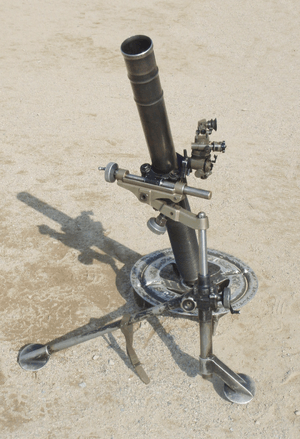 |
Operated by a three-man team. It is often vehicle-borne; in mechanised infantry battalions it is mounted and fired from an FV432 vehicle.[32] Around 470 are in service.[33] |
Anti-armour, structure and air
| Name | Origin | Type | Warhead | Photo | Notes |
|---|---|---|---|---|---|
| MBT LAW | | Anti-tank weapon | 150mm |  | Disposable, man-portable, short range fire-and-forget anti-tank guided missile system. It is designed to "knock out any main battle tank in just one shot by striking it from above".[34] |
| FGM-148 Javelin | | Anti-tank weapon | 127mm | %2C_was_part_of_a_demonstration_at_Imber_Camp%2C_Warminster._MOD_45144621.jpg) | Man-portable medium range anti-tank missile system. It fires a High Explosive Anti Tank (HEAT) warhead and is capable of penetrating explosive-reactive armour.[35] |
| ILAW | | Anti-tank weapon | 84mm |  | Small quantities of AT4 CS HP projectiles have been purchased.[36] |
| L2A1 ASM | | Anti-structure weapon | 90mm |  | Disposable, man-portable guided anti-structure weapon. It is designed to destroy hardened structures, such as bunkers, buildings and other fixed positions.[37] |
| Starstreak MANPAD | |
Anti-air weapon | 22mm x 3 | |
Alongside the LML and Stormer mounted versions, the British Armed Forces also possess the high speed Starstreak Missile on a shoulder mounted and man portable launcher. This can also be used as a surface attack weapon, capable of penetrating the frontal armour of even IFVs.[38] |
Grenades and mines
| Name | Origin | Type | Detonation | Photo | Notes |
|---|---|---|---|---|---|
| L109A1 | |
Frag grenade | Fuse |  |
British version of the Swiss HG 85 Grenade. It differs from the original in that it has a matte black safety clip similar to the American M67 grenade. It has a 3-4 second fuse, contains 155g of high explosive and has a lethal range of 10 m (33 ft). |
| M18 Claymore mine | |
Anti-personnel mine | Remote |  |
Used for specialist and defensive purposes. It has seen use in Afghanistan. It will be replaced with the Fixed Directional Fragmentation Weapon (FDFW), a Finnish designed mine that has yet to be formally identified.[39] |
| L9A8 Bar Mine | |
Anti-tank mine | Pressure | |
Primary anti-tank mine. During the Gulf War, it was found to be highly resistant to mine ploughs, simply rotating under it to detonate below the vehicle, disabling some M60 tanks of the USMC after Iraq captured L9s from the Kuwaiti Army.[40] |
Personal equipment
Protective equipment

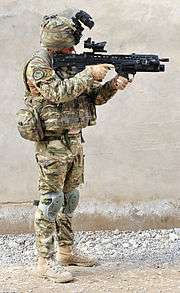
The standard helmet in service is the Mk.7, which replaced the older Mk 6 helmet. The Mk.7 helmet is equipped with a new harness that keeps the helmet more stable on the head when night vision equipment is fitted. It is also better integrated with new weapon sights, making it easier to use in a variety of fighting positions.
Since 2006, troops in Afghanistan (and until 2009 Iraq), have been issued with Osprey body armour. This has provided much better protection than previous body armour systems. The new Mk 4 'Osprey Assault' body armour, which replaced the older Osprey vests, provides the same ballistic protection, while improving the comfort of personnel on operations in Afghanistan. It has all the stopping power of the previous body armour, but is closer fitting, less bulky and is easier to move in. It is specifically developed to meet the British Army's requirements, using cutting edge materials and manufacturing technology.[41]
Both the Mk 7 helmet and the Osprey armour are slated to be replaced by the Virtus system. The Virtus vest is even closer fitting and lighter than the Opsrey Mk 4, and features a quick-release mechanism to aid safe extraction from hazardous situations such as burning vehicles, and a dynamic weight distribution system which, when linked to a user's waist belt, aids in spreading the load of the armour and a bergen or other backpack across the back, shoulders, and hips. The Virtus helmet provides increased blunt impact protection, is specially shaped to allow effective weapon usage while in a prone position, and features a permanent night vision mount and a scalable counterweight attached to the helmet’s rear in order to ease strain on the user’s neck.[42]
In January 2015, over 300,000 General Service Respirators had been delivered to replace the in-service S10 respirator.[43] These respirators are also used by the Royal Navy, Royal Air Force and Royal Fleet Auxiliary.
Multi-Terrain Pattern
The Multi-Terrain Pattern is designed and intended to perform consistently across a wide range of environments. A wide range of camouflage colours were trialled in Britain, Cyprus, Kenya and Afghanistan, ultimately the Crye's "Multicam" pattern was determined to be the best performing, across the widest range of environments (by a significant margin) and was subsequently selected as the basis for the new British MTP camouflage, and combined with the existing British DPM pattern. The MTP pattern itself was not trialled against other patterns and its adoption was based solely on its similarity to the original Crye Multicam pattern.[44]
Boots

In 2012 the MOD purchased a newly designed range of brown combat boots from Haix,[45] Alt-Berg,[46] and other manufacturers for the Army, Royal Navy and RAF to replace the black and desert combat footwear previously worn. Five different boots, developed to match the Multi-Terrain Pattern uniform, are available to Armed Forces personnel depending on where they are based and what role they are in. Each of the five boot types comes in two different styles, with personnel being able to wear the particular style they find most comfortable; the boots have also been designed with different width fittings for the first time to take account of the different shapes of men and women's feet. Black boots have been retained for wear with most non-camouflage uniforms as well as units on parade in full dress uniform, such as regiments performing ceremonial duties in central London.[47][48]
- Desert Combat – worn by dismounted troops conducting medium to high levels of activity in desert type environments with temperatures exceeding 40 °C
- Desert Patrol – worn by drivers/armoured troops conducting lower levels of activity in desert type environments exceeding 40 °C
- Temperate Combat – worn by dismounted troops for medium to high levels of activity in temperate (European) climates
- Patrol – worn by mounted troops (drivers/armoured troops) taking part in lower levels of activity in temperate (European) climates
- Cold Wet Weather – worn by dismounted troops for medium to high levels of activity in temperatures down to −20 °C.
Before the adoption of the brown boots, British troops were issued with desert combat boots manufactured by Meindl[49][50] and Lowa[51] for use in Afghanistan. Both boots remain listed as part of the MOD's 'Black Bag' of operational clothing despite their official replacement by the brown boots,[52] and may be worn by individual soldiers in lieu of the issue footwear.
Bayonet
The current British L3A1 bayonet has a hollow handle that fits over the L85 rifle's muzzle and slots that line up with those on the flash eliminator. The blade is offset to the side of the handle to allow the bullet to pass beside the blade. It can also be used as a multi-purpose knife and wire-cutter when combined with its scabbard. The scabbard also has a sharpening stone and folding saw blade.
Personal Role Radio
A Personal Role Radio (PRR) is distributed to every member of an eight-strong infantry section.[5]
Personal Load Carrying Equipment
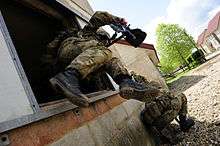
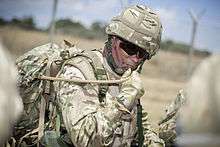
Soldiers need to carry ammunition, water, food and protective equipment. They use Personal Load Carrying Equipment (PLCE), a tough, modular system of camouflaged belt, yoke and pouches. To this can be added two small rucksacks and a large rucksack for additional carrying capacity, when required.[53] The PLCM is due to be upgraded to the new VIRTUS tactical vest next year, with testing with selected units currently taking place.[54]
PLCE is now very unlikely to be spotted on the front-lines due to the introduction of Osprey body armour, though MTP versions do exist and, due to its durability and the quantity produced, the webbing is often seen in use during training exercises.[55][56][57][58]
Future Integrated Soldier Technology
The Future Integrated Soldier Technology (FIST) is a programme under development by the Ministry of Defence. The programme is designed to achieve enhanced military effect through the used of advanced technologies improving the situational awareness, lethality and survivability of soldiers. Ultimately, the programme is part of the wider British Armed Forces doctrine of network-enabled capability. 35,000 sets of kit are expected to be bought and issued between 2015 and 2020. This equipment is designed to bring the British infantryman up to standards and link with new technology currently employed, including the new underslung grenade launcher for the SA80 and the deployed Bowman communications network. It is not intended that every soldier be equipped with FIST: instead, unit commanders will request FIST kits as necessary so that they can be tailored to the situation and mission aims.
Vehicles

Armoured
| Name | Origin | Type | Number | Photo | Notes |
|---|---|---|---|---|---|
| FV4034 Challenger 2 | Main battle tank | 287 |  |
Deliveries comprised 408 vehicles, comprising 386 main battle tanks and 22 driver training tanks. At current, 309 vehicles remain in operational service (287 main battle tanks and 22 driver training tanks). 98 tanks are in climate controlled storage. 60 MBTs were recently removed from storage for active service.[63]
The Challenger 2 equips the heavy armoured cavalry regiments. | |
| In storage | 98 | ||||
| Driver training tank | 22 | ||||
| Total | 407 | ||||
| FV107 Scimitar | Armoured reconnaissance vehicle | 201 | _(CVR(T))_Operating_in_Afghanistan_MOD_45153175.jpg) |
The CVR(T) is a series of armoured fighting vehicles based on a common multi-role chassis. The series first entered service in the 1970s and are now slated to be replaced by the new FRES Specialist Vehicle (SV), Ajax.[64]
The CVR(T) family predominately equips the armoured cavalry regiments in the British Army. | |
| FV103 Spartan | Armoured personnel carrier | 276 | |||
| FV104 Samaritan | Armoured ambulance | 39 | |||
| FV105 Sultan | Armoured command vehicle | 48 | |||
| FV106 Samson | Armoured recovery vehicle | 28 | |||
| Total | 592 | ||||
| FV510 Warrior FV511 Warrior FV512 Warrior FV513 Warrior FV514 Warrior FV515 Warrior |
|
Infantry fighting vehicle Armoured command vehicle Armoured repair vehicle Armoured recovery vehicle Artillery observation vehicle Artillery command vehicle |
482 84 105 39 52 19 Total 781 |
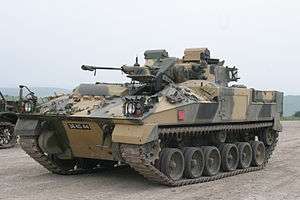 |
The Warrior is designed with the speed, mobility and armour to keep up with the Challenger 2 in armoured formations. 380 of the Warrior family will be upgraded in a £1bn deal with Lockheed Martin UK; 285 of which will receive an improved turret and a new stabilised 40mm CTA International cannon.[65] |
| FV432 Bulldog FV432 Bulldog FV432 Bulldog FV434 Bulldog FV432 81mm |
|
Armoured personnel carrier Armoured command vehicle Armoured ambulance Armoured repair vehicle Mortar carrier |
722 63 110 Total 895 |
 |
Despite entering service during the 1960s, the FV430 series have been in front line service for over 50 years. A recent upgrade programme has "uparmoured" the fleet, which now offers the same levels of protection as the FV510 Warrior.[66] The FV430 series is currently in service with the armoured infantry and mechanized infantry battalions. |
| Cougar Mastiff Ridgback Wolfhound |
|
Protected mobility vehicle Protected mobility vehicle Protected mobility vehicle Protected support vehicle |
30 450 171 125 Total 776 |
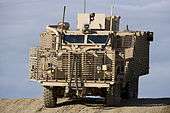 |
The Cougar and Mastiff are 6×6 variants, while the Ridgback is a smaller 4×4 variant. They provide protection and firepower to infantry forces and can be equipped with either a 12.7mm heavy machine gun or a 40mm grenade machine gun.[67] The Wolfhound is a 6×6 armoured tactical support variant of the Mastiff.[68] Following withdrawal from Afghanistan, the MoD has committed to bring 400 Mastiffs, 160 Ridgbacks, and 125 Wolfhounds into the core budget.[69] These vehicles are slated to eventually be replaced by the FRES Utility Vehicle.
As part of Army 2020, these vehicles will replace the Bulldog in equipping mechanized infantry battalions (heavy protected mobility battalions). |
| Foxhound | |
Protected mobility vehicle | 400 | 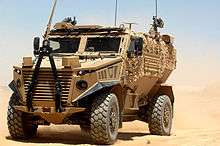 |
Lighter and smaller PMV when compared to other protected vehicles (such as the Mastiff). It is designed for enhanced mobility and fighting in compact urban areas. Despite its weight of 7.2 tons (about three times the weight of the average family car) it can exceed speeds of 70 mph.[70]
As part of Army 2020, the Foxhound equips the light protected mobility battalions. |
| Jackal MWMIK Coyote |
|
Reconnaissance vehicle Protected support vehicle |
502 76 Total 578 |
 |
The Jackal is used for reconnaissance, rapid assault, fire support and convoy protection.[71] It is also used in various configurations by the SAS. The Coyote is a larger 6×6 tactical support vehicle.[72] The MoD has committed to bringing 400 Jackals and 70 Coyotes into the core budget.[69] |
| Land Rover RWMIK Land Rover Snatch Land Rover Panama |
|
Reconnaissance vehicle Protected patrol vehicle Unmanned C-IED |
371 485 12 Total 868 |
 |
The Land Rover RWMIK is a very lightly armoured fire support platform based on the standard Land Rover Wolf chassis. Its low weight makes it highly mobile and ideal for reconnaissance roles and Special Forces.[73] The Land Rover Snatch is based on the "Heavy Duty Chassis", which features much higher levels of armour and protection against IED's.[74] The Panama is an unmanned Land Rover Snatch fitted with IED detecting radar and used within the Talisman Convoys.[75] |
| Vector | |
Protected patrol vehicle | 153 |  |
The Vector is a 6×6 lightly armoured protected patrol vehicle with a high degree of mobility.[76] |
| Husky | |
Protected support vehicle | 338 |  |
Features a high degree of protection against IEDs. It is used to supply food, water and supplies to those on front-line, escorting convoys and protected patrol.[77] The MoD have committed to bring 325 Husky vehicles into the core budget.[69] |
| Panther | Command and control | 401 | .jpg) |
In use with various heavy, medium and light armour formations. Panther is also used as the command vehicle for Engineer Troops, Anti-Tank, Mortar and supporting fire platoons. An option for 400 more vehicles exists.[78] | |
| Viking | |
UAV support | 21 |  |
Amphibious, all-terrain vehicle.[79] 21 were ordered in 2007 to support operations with the Watchkeeper UAV. This role was passed to the Warthog which was then removed from service.[80] |
| TPz Fuchs | |
CBRN reconnaissance | 11 |  |
Previously formed part of the Joint CBRN Regiment.[81] Will be used by Falcon Squadron, Royal Tank Regiment.[82] |
Engineering
| Name | Origin | Type | Number | Photo | Notes |
|---|---|---|---|---|---|
| Titan AVLB Trojan AVRE |
|
Armoured vehicle-launched bridge Assault breacher vehicle |
33 33 Total 66 |
_on_display_at_the_Medium_Capability_Demonstration_Day_at_Bovington_Camp._MOD_45147374.jpg) |
The Titan is an armoured bridge launcher with the capability to deploy a bridge up to 60 meters long. It is based on the Challenger 2 chassis.[83] Trojan is also based on the Challenger 2 chassis and is designed to breach through enemy defences, such as walls or fortifications, and clear paths through minefields. The Trojan is equipped with the Python Minefield Breaching System.[84] |
| Alvis Unipower TBT | |
Tank bridge transporter | 137 | 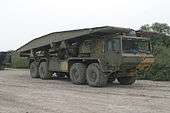 |
The TBT has the same cross-country performance as a tank even when fully loaded. It can carry 1 × No 10 Bridge or 2 × No 12 Bridges. It can deploy, drop off and load bridges independently, but it cannot recover them. |
| CRARRV | |
Armoured recovery vehicle | 75 | _(7527707880).jpg) |
Based on the Challenger 1 chassis and is designed to recover and repair damaged or incapacitated tanks.[85] |
| Terrier | |
Combat engineering vehicle | 60 |  |
Provides mobility support (obstacle and route clearance), counter-mobility (digging of anti-tank ditches and other obstacles) and survivability (digging of trenches and Armoured Fighting Vehicle slots).[86] A total of 60 vehicles were ordered and delivered by December 2014.[87] |
| Alvis Shielder | |
Anti-tank mine layer | 29 |  |
Designed to dispense anti-tank mines to create barriers and deny access to enemy armour. The vehicle carries 40 canisters, each holding six mines.[81] The Shielder has been withdrawn from active service after "a capability review decision".[88] |
| Buffalo | |
Mine-protected clearance | 19 |  |
Mine resistant ambush protected (MRAP) armoured vehicle, which forms part of the British Army's Talisman counter-IED system.[89] |
| JCB HMEE | |
Armored backhoe loader | 13 | 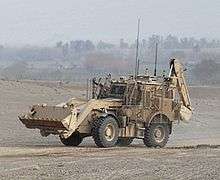 |
Heavily armoured excavator. It forms part of the Talisman counter-IED system. The MoD has committed to bring the HMEE along with all related Talisman elements (Minewolf, Tarantula Hawk, Buffulo, Panama and Talon) into the core budget.[90][91] |
C vehicle fleet

The job of the Royal Engineers is to restrict the enemy's ability to advance, while also allowing friendly combat forces the freedom maneuver as necessary. Other tasks undertaken are bomb disposal, the construction of fortifications, runways, roads and bridges and the improvement of existing infrastructure to support operations - such as improving existing roads for logistic convoys. To achieve this, the Royal Engineers operate a large and diverse fleet of vehicles. At present, the C vehicle fleet is provided by a private finance initiative (PFI) and consists of some 2,500 vehicles of over 160 types of "earthmoving plant, Engineer Construction Plant (ECP) and rough terrain Materials Handling Equipment (MHE)".
The provider of the PFI is Amey Lex Consortium (ALC), which was awarded a 15-year contract in 2005 for £600 million. The handing over of the C vehicle fleet to a PFI has improved overall efficiency, with ALC selecting common chassis for multiple roles and significantly reducing equipment types. This has led to reduced training needs in personnel, commonality of spares and an overall reduction in the logistic footprint and cost of maintenance.[92] ALC maintains the fleet at various degrees of readiness, with a large pool of the vehicles being modified and adapted for military use - however, the majority of the fleet is maintained at commercial standards. The fleet is dispersed worldwide to accommodate both existing and future operations. When in use, the vehicles are essentially being "hired on an ad hoc basis". To help sustain the C vehicle fleet on operations, the PFI includes a logistics support package.[93]
Artillery and air-defence
| Name | Origin | Type | Number | Photo | Notes |
|---|---|---|---|---|---|
| L131 AS-90 | |
Self-propelled artillery | 117 |  |
The L131 AS-90 is a 155mm self-propelled howitzer and is the largest piece of field artillery in the British Army. The L131 is operated by five field regiments of the Royal Horse Artillery and Royal Artillery, including the: 1st Regiment Royal Horse Artillery, 19th Regiment Royal Artillery and the 26th Regiment Royal Artillery. Each regiment typically has 24 guns. |
| L118 Light Gun | |
Towed howitzer | 115 |  |
The L118 Light Gun is used by the 3rd, 4th, 7th and the 29th field artillery regiments of the British Army. It can be towed by a medium-weight vehicle (such as a Pinzgauer) or carried around the battlefield underslung by a Puma or Chinook helicopter. |
| GMLRS | |
Rocket artillery | 50 |  |
The Guided Multiple Launch Rocket System (GMLRS), nicknamed the '70 km Sniper' or 'GSRM (Grid Square Removal System)', provides pinpoint accuracy, delivering a 200 lb high-explosive warhead to its target. It has twice the range of other artillery systems used by the British Army. Operated by 1 RHA, 19 RA and 26 RA. |
| Rapier | |
Surface-to-air missile system | 24 | _MOD_45114028.jpg) |
The Rapier Field Standard C is a technologically advanced Short Range Air Defence System (SHORAD), which is compact, mobile and air-portable, making it suitable for worldwide operations. It is a 24-hour, all-weather guided weapon system with the capability to engage two targets at once. Operated by the 16th Regiment Royal Artillery across four batteries, one of which is permanently based in the Falkland Islands. |
| Starstreak LML | |
Surface-to-air missile system | 145 |  |
The Starstreak Lightweight Multiple Launcher (LML) is a short-range, highly mobile air defence system that holds three missiles ready for firing and can be used as either a stationary launch unit or mounted on a light vehicle, such as a Land Rover. Starstreak can also be used as a surface attack weapon, capable of penetrating the frontal armour of even IFV's. Operated by 12th Regiment Royal Artillery. |
| Starstreak HVM | |
Surface-to-air missile system In Storage |
62 22 |
|
The Starstreak SP HVM is mounted on the Alvis Stormer AFV with an 8-round launcher and internal stowage for a further 12 missiles. The Starstreak HVM (High Velocity Missile) is designed to counter threats from very high performance, low-flying aircraft and fast 'pop up' strikes by helicopters. An additional 22 systems are in climate controlled storage. Operated by 12th Regiment Royal Artillery. |
Mobile artillery monitoring battlefield radar
_MOD_45148327.jpg)
The Mobile Artillery Monitoring Battlefield Radar ( or Mobile Artillery Monitoring Battlefield Asset) is a counter-battery radar. It detects enemy artillery projectiles fired by one or more weapons and from their trajectories locates the position of the weapon that fired it. It has a detection range of up to 30 km and can process up-to 100 projectiles simultaneously. It is mounted on a Bandvagn 206 (Bv206) all-terrain vehicle. Five vehicles are operated by the 5th Regiment Royal Artillery.
Centurion C-RAM
The Centurion C-RAM is a land based variant of the Phalanx CIWS 20mm gatling cannon. Covering a 1.2 km square area, they intercept incoming artillery munitions via radar and FLIR guidance firing at a rate of 4,500 rounds per minute. At least six were acquired for deployment in Iraq with the British Army; they are now contracted for eventual conversion by Babcock International into naval variants for use on the Queen Elizabeth-class aircraft carriers.[94]
Exactor
The Exactor is a previously classified purchase of Spike-NLOS pods originally mounted on an M113 chassis. The system is primarily used for precise indirect attacks at long ranges (26 km (16 mi)). Exactor is to be brought into the core budget, with options to be remounted on a less specialist and more expeditionary focused chassis.[95] It is used as an ultra-long range anti-armour and anti-structure weapon, where the GMLRS would result in too much collateral damage. 18 such systems now exist within the Royal Artillery in six batteries of three, with some remounted on more mobile trailers.[96]
Logistics
| Name | Origin | Type | Number | Photo | Notes |
|---|---|---|---|---|---|
| Oshkosh HET 1070F | |
Military logistics vehicle | 157 | 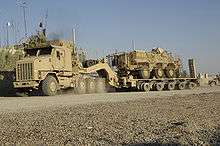 |
The Oshkosh HET 1070F is the Heavy Equipment Transporter (HET) of the British Army. The Heavy Equipment Transporters are capable of carrying a 72-tonne Main Battle Tank and are responsible for the strategic transportation of armoured vehicles over land. |
| Oshkosh Wheeled Tanker | |
Military logistics vehicle | 762 |  |
The Oshkosh Wheeled Tanker forms the backbone of the British Army's bulk fuel and water transportation. The Tanker can be fitted with enhanced blast-proof armour for driver protection and General Purpose Machine Guns. |
| MAN Support Vehicle | |
Military logistics vehicle | 7,285 |  |
The MAN family of support vehicles are gradually replacing all 4-tonne, 8-tonne and 14-tonne cargo vehicles currently in service. They have good mobility and the ability to be fitted with armour and General Purpose Machine Guns. 7,285 were ordered in April 2010. |
| Leyland DROPS (MMLC) Foden DROPS (IMMLC) |
|
Military logistics vehicle | 1,800 | _in_Afghanistan_MOD_45153716.jpg) |
The Leyland MMLC is the Medium Mobility Load Carrier (MMLC) using a standard pallet and rack system and forms the logistic backbone of the British Army. The Foden IMMLC is the Improved Medium Mobility Load Carrier and is used primarily as an ammunition carrier in support of AS90 155mm self-propelled guns. |
| Bedford TM 6-6 Bedford TM 4-4 |
|
Military logistics vehicle | |
The Bedford TM 6-6 is a 12-ton, six wheel military logistics vehicle equipped with a crane and a flat bed section for the transportation of supplies. It entered service in 1986 and is now being replaced by more modern vehicles, such as the MAN Support Vehicles. The Bedford TM 4-4 is a smaller four wheel military logistics vehicle armed with a 7.62mm GPMG. It is used as a troop transport and supply vehicle. |
Miscellaneous
| Name | Origin | Type | Number | Photo | Notes |
|---|---|---|---|---|---|
| Pinzgauer | |
Tactical support vehicle | 190 | |
The Pinzgauer 716M is 4×4 tactical support vehicle used by the Royal Artillery to tow artillery pieces, such as the Rapier and L118 Light gun.[76] |
| Mowag Duro II Mowag Duro III |
|
Communications, intel and bomb disposal | 190 |  |
118 Duro II and 48 Duro III are operated by communications and intelligence units. A further six Duro II and 18 Duro III are tasked with mine clearance and bomb disposal units - these have become known as Tellar and Citizen in British Army service.[97]'[98][99] |
| Land Rover Wolf Land Rover Defender |
|
Multipurpose utility vehicle | 12,000 |  |
Numerous variants of the Land Rover are used such as the:[100]
|
| Land Rover ''Pulse'' | |
Battlefield ambulance | 119 | .jpg) |
The Land Rover battlefield ambulance has full medical facilities with the capacity to hold up to six seated casualties or four casualties on stretchers. The Vehicle can be airlifted.[101] |
All-terrain vehicles
There are a number of all-terrain vehicles in service with the British Army. The Supacat ATMP is a lightweight 6×6 used by airborne and air-mobile forces. It can carry up to 8 troops with a standard NATO pallet of stores and ammunition. The Springer all-terrain vehicle is a light-role 4×2 load carriage platform, which can self-load a 1-ton pallet. Each vehicle is equipped with an 8,000 lb (3,600 kg) self-recovery winch and sand ladders, which act as loading ramps for a cargo pallet.[102][103] Approximately 900[104] Grizzly 450 quad bikes are used as light transport for things such as mortars, ammunition and general supplies.[103][105] Finally, the Harley Davidson MT350E and Honda R250 motorcycles are used by dispatch riders and for a variety of liaison and traffic control tasks.
Special forces
The Special forces maintain a unique fleet of vehicles to support their covert operations. In 2001, 65 Supacat High Mobility Transporter (HMT) 400 vehicles were ordered under Project Minacity after being in development for a special forces protected vehicle requirement since the late 1990s.[106] The Minacity vehicles entered service in 2003 in Afghanistan.[107] In 2008, 24 Australian Bushmaster armoured vehicles were purchased under a UOR for the SAS in Iraq providing all-round protection unlike the Minacity with an exposed crew.[108][109] It is fitted with additional armour, counter-IED electronics, and a .50 calibre machine gun mounted in a RWS.[110] In addition, other vehicles known to be in service are: 60 Toyota Hilux for special forces mobility; and 78 ACMAT VLRAs as tactical support vehicles to resupply and sustain special forces on operations.[111][112] In August 2016, the BBC reported that the Jankel Toyota Land Cruiser-based Al-Thalab long range patrol vehicle was being used in Syria.[113]
Aircraft
| Name | Origin | Type | Number | Photo | Notes |
|---|---|---|---|---|---|
| Britten-Norman Islander Mk1 Britten-Norman Islander Mk2 |
|
Command and control | 4 | .jpg) |
Light aircraft used for airborne reconnaissance, command and communications, also has a limited use in transporting personnel. It has a range of 380 nautical miles and can carry two crew and six passengers. |
| Britten-Norman Defender | |
Command and control | 9 |  |
Light aircraft used for airborne reconnaissance, command and communications. It has a range of 380 nautical miles and can carry two crew and six passengers. Also has a limited use in transporting personnel. Often used by the UK Special Forces. |
| Westland Apache | |
Attack helicopter | 67[114] |  |
British version of the Apache; uses more powerful Rolls-Royce RTM332 engines to allow it to operate with both full fuel and munitions loads. It carries a mix of weapons, including rockets, Hellfire missiles, and a 30-mm chain gun. 16 of the Army's 67 Apache helicopters have been mothballed.[114] |
| Westland Lynx AH9A | |
Battlefield helicopter | 21 | 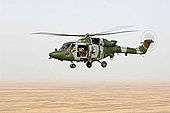 |
Utility helicopter, often used to provide close air support to ground forces with the use of machine guns. The AH9 aircraft have been upgraded to AH9A standard as part of the UOR processes inspired by operations in Afghanistan.[115] |
| Westland Wildcat | |
Battlefield helicopter | 21[116] | .jpg) |
A total of 34 aircraft have been ordered,[117] 4 in the LAH configuration to be operated by the Joint Special Forces Aviation Wing. The Wildcat brings enhancements in ISTAR ability, range and payload capacity over the Lynx AH7 as well as operating an advanced system architecture for cross communication between air and ground. |
| Bell 212 HP | |
Battlefield helicopter | 8 |  |
Used in the jungle areas of Belize and Brunei. |
| Eurocopter AS365N3 Dauphin II | |
Special forces helicopter | 5 | .jpg) |
Used by No. 658 Squadron AAC in support of the United Kingdom Special Forces attached to the SAS.[118] |
| Westland Gazelle AH1 | |
Reconnaissance helicopter | 34 |  |
Small, single-engined helicopter primarily used for observation and reconnaissance.[119] |
| Watchkeeper WK450 | |
ISTAR UAV | 30 | 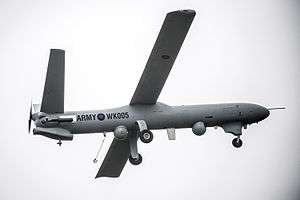 |
Advanced ISTAR UAV that can handle two payloads, operate in all weathers and can also take-off and land automatically.[120] A total of 30 air vehicles and 14 ground systems had already been produced in 2014, with an additional 24 air vehicles and one ground system to be delivered.[121][122] Operated by 32nd Regiment Royal Artillery. |
Watercraft
| Name | Origin | Type | Boats | Photo | Notes |
|---|---|---|---|---|---|
| Mk 4 Army Workboat | |
Workboat | Storm (WB41) Diablo (WB42) Mistral (WB43) Sirocco (WB44 ) |
Operated by the Royal Logistic Corps as small tugs and general purpose work-boats in support of amphibious operations. They have a displacement of 48 tonnes and a maximum speed of 10 knots.[123] |
Raiding craft

The raiding craft in service with the British Army are operated in large numbers, predominately with the Royal Engineers and the Royal Logistic Corps, for supporting both bridging and amphibious operations. These craft are highly versatile and often find themselves serving in environments ranging from the Arctic to the tropics.[124]
Mexeflotes
Mexeflotes are amphibious landing raft operated by the Royal Logistic Corps for amphibious operations and are designed to deliver both armoured vehicles and material from ship to shore. They are deployed on the 16,160 tonne Bay-class landing ships of the Royal Fleet Auxiliary.
Future equipment

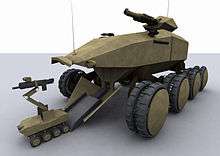
- The Future Integrated Soldier Technology is a suite of equipment capable of enhancing an infantryman's effectiveness as part of the Future Soldier programme.[125]
- The Future Rapid Effect System was a planned family of medium-weight armoured vehicles intended to replace the CVR(T) series of vehicles. This has been replaced by the Scout SV known as "Ajax" in British service and its variants.
- An ABSV will replace some vehicles, such as the mortar carriers, in armoured infantry units[126]
- The MAN Support vehicle is currently being introduced into service. There will be 6,928 cargo vehicles, including unit support tankers, 288 recovery vehicles and 69 recovery trailers. Deployment is planned for 2014.[127]
- UK MOD has a requirement to acquire a new Modular Assault Rifle System (MARS) for deployment with certain military units from 2014.[128]
- A new body armour system known as Virtus is under development as a replacement for the Osprey vest and Mk. 7 helmet.[42]
- The MoD has a requirement for a new multi role vehicle under the Multi Role Vehicle-Protected (MRV-P) requirement with main gate expected in 2017. At DSEI 2015 General Dynamics UK announced that they would offer variants of their Ocelot (Foxhound) and Eagle vehicles for the requirement.[129][130]
- The British Army wants to purchase 8x8 wheeled armoured fighting vehicles to replace the Mastiff and Ridgeback in British Service. This program used to be part of FRES UV, later named simply UV (Utility Vehicle) and now known as Mechanised Infantry Vehicle (MIV). This vehicle is intended to equip the 3 "heavy protected mobility" battalions under Army 2020. They will also be part of the 2 Strike Brigades proposed under the Strategic Defence and Security Review 2015.[131]
- Senior army officers and procurement officials are looking at either upgrading the Challenger 2 or outright replacing it. At DSEI 2015, army officials expressed their concern with the Challenger 2's armament and its inevitable obsolescence in coming years. Other causes of concern are the Challengers engine and electronics. The army stated that they had been in discussions with armoured fighting vehicle manufacturers about the future of the tank and its potential replacement.[132] A later Defense News article said that the British Army would still proceed with its Challenger 2 LEP, citing that a replacement at the present would be too costly.[133]
- Under the Non-Articulated Vehicle – Protected (NAV-P) program, the MoD is looking for a successor to the DROPS vehicles.[134]
See also
- Other equipment lists
- Royal Engineers bridging and trackway equipment
- British Army communications and reconnaissance equipment
- Unmanned systems of the British Army
- Related articles
References
- ↑ "Urgent Operational Requirements (UOR)". Ministry of Defence (United Kingdom). Retrieved 7 February 2010.
- ↑ Major General WH Moore CBE (Winter 2008). "The UOR Advantage". Defence Management Journal: 79.
- ↑ SpecterOS™ 4X sight by Raytheon ELCAN selected for UK MoD FIST programme (elcan.com)
- 1 2 New Army Kit Helps Soldiers See More Clearly (gov.uk)
- 1 2 "Personal Role Radio". Ministry of Defence (United Kingdom). Retrieved 28 January 2010.
- ↑ "British Military Adopts Glock 17 Generation 4" - Modernserviceweapons.com, 12 January 2013
- ↑ "Glock 17". Ministry of Defence. Retrieved 5 May 2014.
- ↑ "SA80 individual weapon". Ministry of Defence (United Kingdom). Retrieved 5 May 2014.
- ↑ Defence Update: Thales Awarded £150 million FIST Order, September 2009.
- ↑ "Light support weapon". Ministry of Defence (United Kingdom). Retrieved 5 May 2014.
- 1 2 http://www.thinkdefence.co.uk/2014/06/l119a2-colt-canada-c8-upgrade/
- ↑ http://defence.pk/threads/uk-royal-marine-unit-ditches-the-sa80-for-colt-c8.424492/
- ↑ "SAS Weapons - C8 SFW Carbine (L119A1)". eliteukforces.info. Retrieved 7 May 2014.
- ↑ "L129A1 sharpshooter rifle". Ministry of Defence (United Kingdom). Retrieved 5 May 2014.
- ↑ "Rifles made in the Q-C help protect Olympics". Quad-City Business Journal. Retrieved May 12, 2013.
- ↑ Harding, Thomas (June 26, 2009). "SAS parachuted in to Baghdad". The Telegraph. Retrieved 2011-01-30.
- ↑ "Combat Shotgun". British Army Website. Ministry of Defence (United Kingdom). Retrieved 28 January 2010.
- ↑ Skennerton, Ian D. (2005). "L-prefix Nomenclature". Enfield Collector. Ian Skennerton. Retrieved 6 January 2010.
- ↑ Kommando International Special Operations Magazine, K-ISOM, Ausgabe 5, Mai/Juni 2009
- ↑ "L115A3 Long range 'sniper' rifle". Ministry of Defence (United Kingdom). Retrieved 5 May 2014.
- ↑ "EXCLUSIVE: SAS team halt Islamic State attack in Iraq with just TWO shots". 11 October 2014.
- ↑ Gander, Terry (2006). Jane's Infantry Weapons 2006-2007. Jane's Information Group. p. 22. ISBN 0-7106-2755-6.
- ↑ The Illustrated Directory of 20th Century Guns. Salamander Books Ltd. ISBN 978-1-84065-245-1.
- ↑ "Light Machine Gun (LMG)". Ministry of Defence (United Kingdom). Retrieved 28 January 2010.
- ↑ FN Herstal (June 8, 2011). "FN MINIMI™ 7.62 Machine Gun Selected by British Military". army-technology.com. Retrieved 14 May 2012.
- ↑ "British Army to review use of belt-fed weapons and light mortars - IHS Jane's 360".
- ↑ "General Purpose Machine Gun". Ministry of Defence (United Kingdom). Retrieved 28 January 2010.
- ↑ ".50 cal M2 HMG QCB".
- ↑ "Heavy Machine Gun (HMG)". Ministry of Defence (United Kingdom). Retrieved 28 January 2010.
- ↑ "Grenade Machine Gun". Ministry of Defence (United Kingdom). Retrieved 28 January 2010.
- ↑ "British Army Vehicles and Equipment" (PDF). Ministry of Defence (United Kingdom).
- ↑ "81mm Mortar". Ministry of Defence (United Kingdom). Retrieved 28 January 2010.
- ↑ "UK Defence Summary". ArmedForces.co.uk.
- ↑ "NLAW". Ministry of Defence (United Kingdom). Retrieved 5 May 2014.
- ↑ "Javelin Medium Range Anti-tank Guided Weapon". Ministry of Defence (United Kingdom). Retrieved 28 January 2010.
- ↑ Kemp, Ian (April–May 2006), "The law gets tougher: the shoulder-launched light anti-armour weapon has evolved to become a multipurpose assault weapon much in demand for asymmetric warfare", Armada International, ISSN 0252-9793.
- ↑ "Dynamit Nobel selected in February 2006 to develop, supply and support the ASM". Armada International. 2007-08-01.
- ↑ Starstreak high velocity missile - British Army Website
- ↑ Light Infantry and Regular-Reserve Integration, sasc-comrades.org, Accessed 3 December 2014
- ↑ Gordon, Michael R.; Trainor, General Bernard E. (1995). The Generals' War. Little, Brown and Co. pp. 369–360. ISBN 0-316-32100-1.
- ↑ "Combat body armour". Ministry of Defence (United Kingdom). Retrieved 6 May 2014.
- 1 2 "New Virtus body armour for infantry troops". Ministry of Defence (United Kingdom). Retrieved 15 August 2015.
- ↑ desider (PDF). Ministry of Defence. 9 January 2015. Retrieved 9 January 2015.
- ↑ "Personal clothing". Ministry of Defence (United Kingdom). Retrieved 6 May 2014.
- ↑ "NEW UK FORCES FOOTWEAR - Brown Boots By Haix - Combat & Survival". 31 December 2012.
- ↑ "SOMETHING FOR THE LADIES - Alt-Berg's Female Lasts - Combat & Survival". 1 August 2013.
- ↑ "Combat boots". Ministry of Defence (United Kingdom). Retrieved 6 May 2014.
- ↑ "Deal signed for new combat boots". Ministry of Defence (United Kingdom). Retrieved 15 August 2015.
- ↑ House of Commons Hansard Written Answers for 13 Nov 2007 (pt 0010)
- ↑ Elliot, John; Main, Graeme (2008), "Kitstop: Walking Back to Happiness", Soldier Magazine - Magazine of the British army (February 2008): 44–45
- ↑ "Lowa, Magnum & Meindl UK Forces Combat Boots - Combat & Survival". 31 December 2011.
- ↑ "What's in The Black Bag?" (PDF). Ministry of Defence (United Kingdom). Retrieved 15 August 2015.
- ↑ "Personal Load Carrying Equipment". Ministry of Defence (United Kingdom). Retrieved 28 January 2010.
- ↑ "UK Armed Forces Commentary: Light Role Infantry battalions and Regular - Reserve integration".
- ↑ "16 Air Assault Brigade prepares for American exercise". Ministry of Defence (United Kingdom). Retrieved 15 August 2015.
- ↑ "American exercise marks airborne anniversary". Ministry of Defence (United Kingdom). Retrieved 15 August 2015.
- ↑ "West Country Reservists in Cyprus exercise". Ministry of Defence (United Kingdom). Retrieved 15 August 2015.
- ↑ "Reservists in final training week of the year". Ministry of Defence (United Kingdom). Retrieved 15 August 2015.
- ↑ House of Commons Hansard Written Answers (publications.parliament.uk), January 2012
- ↑ House of Commons Hansard Written Answers (publications.parliament.uk), July 2012
- ↑ House of Commons Hansard Written Answers (publications.parliament.uk), September 2013
- ↑ House of Commons Hansard Written Answers (publications.parliament.uk), February 2014
- ↑ will.warren (9 March 2016). "Tanks And Trucks Tear It Up On Salisbury Plain".
- ↑ "Scimitar armoured reconnaissance vehicle". Ministry of Defence (United Kingdom). Retrieved 6 May 2014.
- ↑ "Long-life Warrior [DSEi15D3]url=http://www.janes.com/article/54488/long-life-warrior-dsei15d3". ISH Janes.
- ↑ "Bulldog & FV430 series". Ministry of Defence (United Kingdom). Retrieved 6 May 2014.
- ↑ "Mastiff". Ministry of Defence (United Kingdom). Retrieved 6 May 2014.
- ↑ "Wolfhound". Ministry of Defence (United Kingdom). Retrieved 6 May 2014.
- 1 2 3 UK firms up UOR to core vehicle numbers (IHS Jane's Defence Weekly) 16 December 2013
- ↑ "Foxhound". Ministry of Defence (United Kingdom). Retrieved 6 May 2014.
- ↑ "Jackal 2 armoured vehicle". Ministry of Defence (United Kingdom). Retrieved 6 May 2014.
- ↑ "Coyote TSV (light)". Ministry of Defence (United Kingdom). Retrieved 6 May 2014.
- ↑ "RWMIK Land Rover". Ministry of Defence (United Kingdom). Retrieved 6 May 2014.
- ↑ "Snatch 2 Land Rover". Ministry of Defence (United Kingdom). Retrieved 6 May 2014.
- ↑ "UK Operation Panama active in Afghanistan - News - Shephard".
- 1 2 "Vector". Ministry of Defence (United Kingdom). Retrieved 6 May 2014.
- ↑ "Husky". Ministry of Defence (United Kingdom). Retrieved 6 May 2014.
- ↑ "Panther". Ministry of Defence (United Kingdom). Retrieved 6 May 2014.
- ↑ "Viking BVS10". Ministry of Defence (United Kingdom). Retrieved 6 May 2014.
- ↑ "Armoured Fighting Vehicles:Written question - 31305".
- 1 2 "British Army Vehicles and Equipment" (PDF). Ministry of Defence (United Kingdom). Retrieved 6 May 2014.
- ↑ https://www.gov.uk/government/uploads/system/uploads/attachment_data/file/417372/20150326_DE_S_Corporate_Plan_Final.pdf page 25
- ↑ "Titan armoured bridge launcher". Ministry of Defence (United Kingdom). Retrieved 6 May 2014.
- ↑ "Trojan armoured vehicle". Ministry of Defence (United Kingdom). Retrieved 6 May 2014.
- ↑ "Challenger armoured repair & recovery vehicle". Ministry of Defence (United Kingdom). Retrieved 6 May 2014.
- ↑ "Terrier". Ministry of Defence (United Kingdom). Retrieved 6 May 2014.
- ↑ "BAE Systems delivers last Terrier CEV". IHS Jane's 360. 29 December 2014. Retrieved 31 December 2014.
- ↑ Ministry of Defence Annual Report and Accounts 2013-2014 (pdf), gov.uk, Accessed 1 December 2014
- ↑ "Force Protection Receives Multiple Buffalo Vehicle Orders". Business Wire. 2008-11-13. Retrieved 2011-10-29.
- ↑ WWL ships JCB military excavators to the UK (2wglobal.com)
- ↑ "Desider Magazine - Issue 72" (PDF). www.gov.uk. Retrieved 6 May 2014.
- ↑ ALC - C VEHICLE CAPABILITY (PDF), alcvehicles.com
- ↑ Army Vehicles and Equipment (PDF), army.mod.uk
- ↑ "Babcock to deliver further Phalanx Systems" Babcock International
- ↑ Jane's Special Report on Exactor, 24 September 2013
- ↑ bmpd (11 August 2014). "Британский ракетный комплекс Exaсtor Mk 2".
- ↑ "Newest Munitions Disposal Vehicle Is Launched" MoD Defence News
- ↑ GD MOWAG’s Duro Light Vehicle Family Racking Up Wins (defenseindustrydaily.com)
- ↑ "AESP_details".
- ↑ "The Royal Logistic Corps" (www.armedforces.co.uk)
- ↑ Land Rover battlefield ambulance, army.mod.uk
- ↑ Forces TV (8 March 2011). "Mean machines showcase recovery service for damaged combat vehicles 07.03.11" – via YouTube.
- 1 2 House of Commons Hansard Written Answers (publications.parliament.uk), 12 February 2014
- ↑ "20150513 FOI2015 04115 Bellinson quads O.pdf" (PDF).
- ↑ "Quad bikes". Ministry of Defence. Retrieved 10 November 2011.
- ↑ Connors, Shaun (9 April 2014). "Briefing: Wheels of the Elite". Jane's Defence Weekly. 51 (20). ISSN 0265-3818.
- ↑ "UKSF to evaluate General Dynamics' Flyer-72". Jane's International Defense Review (Volume 47 Issue 10). 1 October 2014.
- ↑ Dodd, Mark (14 May 2008). "Brits buy our army vehicles". The Australian. Retrieved 2008-05-14.
- ↑ "Mobility Troop - Bushmaster IMV". eliteukforces.info. Retrieved 6 May 2014.
- ↑ Neville (2011), p. 42
- ↑ "New off-road toys for our special forces boys". 28 June 2014.
- ↑ Jane's Defence Weekly, 16 April 2014, Page 26
- ↑ Sommerville, Quentin (8 August 2016). "UK special forces pictured on the ground in Syria". BBC News. Amman, Jordan. Retrieved 18 August 2016.
- 1 2 "UK mothballs quarter of Apache fleet with end of Afghan ops", janes.com, 19 March 2015
- ↑ "Lynx AH9A Upgrade Program and Lynx Wildcat « Fast Air Photography". Fast-air.co.uk. 2011-12-15. Retrieved 2012-03-24.
- ↑ "Agustawestland funded for FASGW integration on Wildcat"
- ↑ "UK Royal Navy primed to receive first Lynx Wildcat", flightglobal.com 12 December 2012
- ↑ Tim Ripley (10 December 2008). "UK Army Air Corps received Dauphins". Jane's Defence Weekly. 45 (50): 10.
- ↑ "Aircraft". Ministry of Defence (United Kingdom). Retrieved 2 February 2010.
- ↑ "Unmanned Aerial Vehicles". Ministry of Defence (United Kingdom). Retrieved 2 February 2010.
- ↑ "British Watchkeeper UAV Finally Cleared to Enter Military Service", 5 March 2014
- ↑ "UKs Watchkeeper Fleet Completed by End Year"
- ↑ Bush, Steve (2014). British Warships and Auxiliaries. Maritime Books. pp. 94–95. ISBN 1904459552.
- ↑ British Army - Assault boats & landing craft, Retrieved 21 June 2014
- ↑ "New targeting technology for troops in Afghanistan". Ministry of Defence (United Kingdom). Retrieved 5 February 2010.
- ↑ "Design selected for future armoured vehicle for British Army". Ministry of Defence (United Kingdom). Archived from the original on 3 September 2009. Retrieved 5 February 2010.
- ↑ Support Vehicle, army.mod.uk
- ↑ Supply of Modular Assault Rifle System, government-online.net
- ↑ "DSEI 2015: General Dynamics outlines its proposal for MRV-P - IHS Jane's 360".
- ↑ https://www.gov.uk/government/uploads/system/uploads/attachment_data/file/526950/DES_Corporate_Plan_201619-20160526.pdf
- ↑ "SDSR 2015 Defence Fact Sheets" (PDF). British Government. 1 November 2015. Retrieved 30 July 2016.
- ↑ "DSEI 2015: British Army considers new MBT in response to Russia's Armata - IHS Jane's 360".
- ↑ "UK Army To Extend Life of Challenger 2; New Tank Too Costly". Defense News.
- ↑ http://www.dtic.mil/ndia/2014tactical/SessionIIIRafferty.pdf
External links
- Equipment - British Army - Official British Army website managed by the Ministry of Defence.
- Equipment on the British Army Rumour Service - The British Military Open Encyclopedia.
- Defence Suppliers Directory - Defence industry database.
- Discover Military - British Army
- British Special Forces & Elite Units - Information on equipment used by the SAS and other UK special forces.
